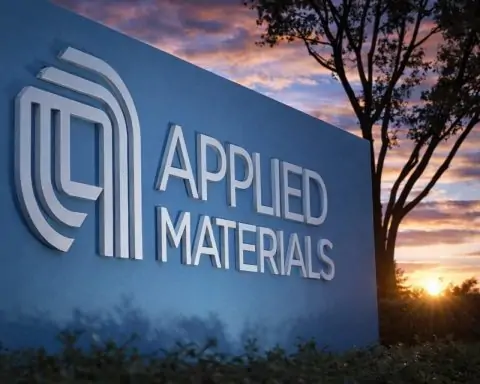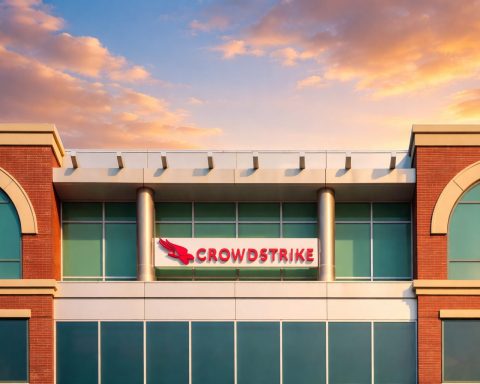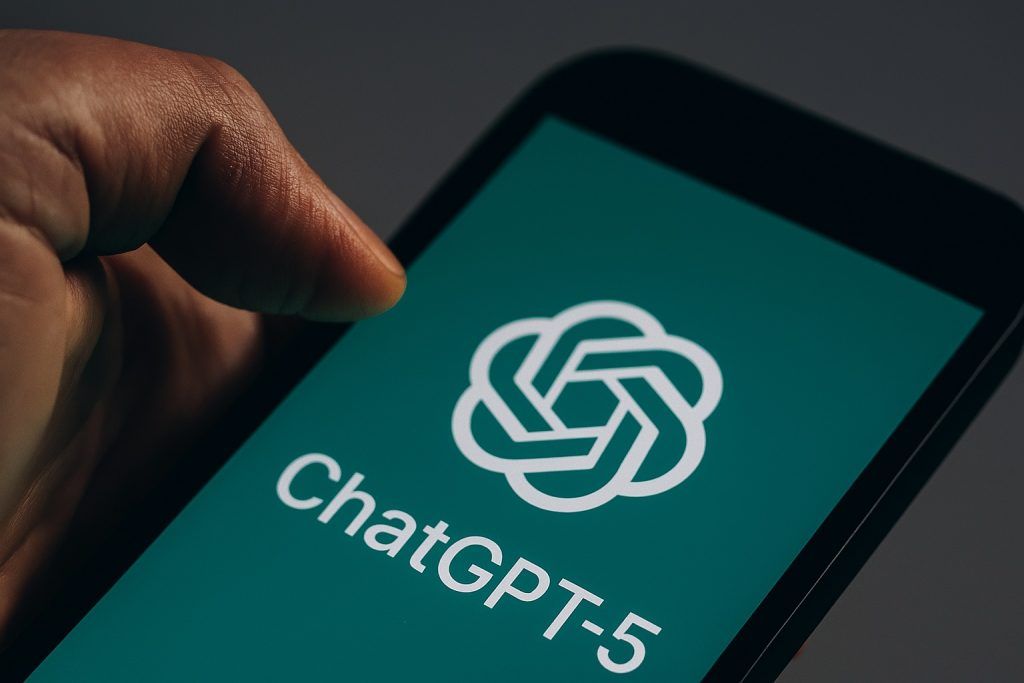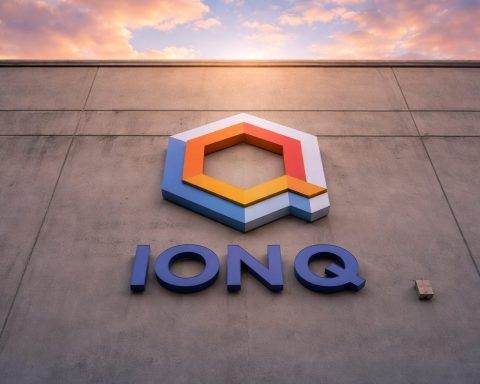-
<li Researchers from the University of Cambridge (UK) and Université Paris-Saclay (France) unveiled an organic diradical molecule whose fluorescence hue depends on spin alignment, orange for parallel (triplet) and near-infrared for antiparallel (singlet) spins, in Nature Chemistry with Rituparno Chowdhury as first author.
<li A France-based team from C12 Quantum Electronics and École Normale Supérieure achieved a 1.3 microsecond qubit coherence time in a purified 12C nanotube electron-spin qubit, using a suspended carbon nanotube double quantum dot in a microwave cavity at 0.3 K and controlled by cavity photons.
<li Pan Jianwei’s team at the University of Science and Technology of China arranged 2,024 rubidium atoms into 2D and 3D arrays with AI-driven lasers, achieving real-time control and fidelities of 99.97% for single-qubit and 99.5% for two-qubit operations.
<li Caltech demonstrated a hybrid quantum memory that stores superconducting qubit states as phonons, extending storage coherence up to 30× longer at cryogenic GHz operation.
<li A 2018 Science paper claiming Majorana evidence was issued a 20-page correction in Science, reigniting debate over data validity and the pursuit of Majorana-based qubits.
<li At the ACS Fall 2025 conference, St. Jude Children’s Research Hospital researchers used quantum computing plus AI to generate about 1,000,000 candidate molecules for KRas, refining to 15 for synthesis and observing two compounds that bound and inhibited KRas in cell tests.
<li Fujitsu announced a superconducting quantum computer with over 10,000 qubits, aiming for 250 logical qubits in 2030 and 1,000 logical qubits by 2035 under the STAR fault-tolerant architecture.
<li IonQ and Oak Ridge National Laboratory demonstrated a quantum-classical hybrid approach that solved a Unit Commitment problem for a 26-plant grid over 24 hours using IonQ’s 36-qubit Forte system.
<li Rigetti Computing announced 99.5% two-qubit gate fidelity on its 36-qubit superconducting processor, with plans to launch the system on August 15 and to reach 100+ qubits at similar fidelity by late 2025.
<li QuamCore unveiled a $26 million Series A (including a $4 million government grant) to pursue a million-qubit quantum computer, proposing a novel superconducting architecture capable of up to 1,000,000 qubits in a single cryostat.
August 2025 was a banner month for quantum computing and technology, marked by significant breakthroughs in research, major corporate moves, new government initiatives, hefty startup funding rounds, and unprecedented international collaborations. From record-setting experiments in the lab to billion-dollar bets by industry and governments, the global quantum ecosystem saw rapid advancement on multiple fronts. Below is a comprehensive roundup of the month’s top quantum developments, organized by category and region, with expert insights highlighting both the excitement and the caution surrounding the quantum revolution.
Academic & Research Breakthroughs
- Spin-to-Light Quantum Sensing (UK/France): Researchers at the University of Cambridge (UK) and Université Paris-Saclay (France) unveiled a novel molecular system that directly links an electron’s spin state to the color of light the molecule emits [1] [2]. In their Nature Chemistry study, they engineered an organic diradical molecule whose fluorescence visibly changes hue depending on the spin alignment of two unpaired electrons – orange light for parallel spins (triplet state) and near-infrared for antiparallel (singlet) [3] [4]. “This allows you to very easily detect and know the quantum state of the molecule just by looking at the color,” explained first author Rituparno Chowdhury [5]. By providing a simple optical readout of spin, this low-cost organic approach could revolutionize quantum sensors and devices, replacing more exotic materials like NV-diamond centers [6].
- Record Qubit Coherence in Carbon Nanotubes (France): A team from startup C12 Quantum Electronics and École Normale Supérieure in Paris achieved a 100× improvement in qubit coherence using a carbon-based quantum device [7] [8]. They reported an electron spin qubit in a purified ^12C nanotube with a coherence time of ~1.3 microseconds – about 10× longer than typical silicon spin qubits under similar conditions [9] [10]. The device, described in Nature Communications, was a suspended carbon nanotube double quantum dot integrated in a microwave cavity at 0.3 K [11]. By eliminating nuclear-spin noise (using isotope-pure carbon) and avoiding any substrate, the qubit’s environment was dramatically quieted [12]. Notably, the team used cavity photons (not external magnetic fields) to control the qubit, further suppressing decoherence [13] [14]. The result – stable quantum oscillations lasting over a microsecond – “revives interest in carbon nanotubes as a promising platform” for scalable quantum processors, suggesting carbon-based qubits could become serious contenders for long-lived, high-fidelity quantum bits [15] [16].
- 2,000+ Neutral Atoms Arrayed by AI (China): In a major leap for neutral-atom quantum computing, physicist Pan Jianwei’s team at the University of Science and Technology of China used AI-driven lasers to arrange 2,024 rubidium atoms into precise 2D and 3D arrays – 10× larger than previous atom arrays [17] [18]. As reported by South China Morning Post and published in Physical Review Letters, the group developed a real-time AI control system with a spatial light modulator that can simultaneously position thousands of atoms via optical tweezers in just 60 milliseconds [19] [20]. Crucially, the total arrangement time did not increasewith more atoms, implying the method could scale to tens of thousands of qubits without slowing down [21] [22]. The demonstration achieved world-class fidelities (99.97% for single-qubit ops, 99.5% for two-qubit) on par with leading U.S. labs [23] [24]. Pan – often dubbed China’s “father of quantum” – noted this addresses a key bottleneck in scaling neutral atoms, which are inherently stable and promising for dense quantum architectures [25] [26]. The breakthrough marks a step toward “a global network of secure, quantum communication” and large-scale neutral-atom quantum machines [27] [28].
- Quantum Memory with Sound (USA): A Caltech team developed a hybrid quantum memory that stores superconducting qubit states as sound waves, prolonging storage times up to 30× versus prior methods [29] [30]. The device couples a qubit on a chip to a tiny mechanical oscillator – essentially a nano-scale tuning fork – that converts the qubit’s electrical state into high-frequency vibrations (phonons) and back [31] [32]. By “parking” quantum information in sound form, the team achieved significantly longer coherence for the stored states [33] [34]. This approach, published in Nature Physics, works at the same cryogenic temperatures and GHz frequencies as the qubits, making for an easy integration [35]. “Once you have a quantum state, you might not want to do anything with it immediately…you need a way to come back to it,” explained Caltech’s Mohammad Mirhosseini, noting such on-chip quantum memories are critical for scaling up algorithms [36] [37]. The advance offers a compact, energy-efficient route to buffer quantum information, potentially enabling networks of quantum modules and more complex computations.
- Majorana Qubit Controversy Rekindled (Denmark/USA): A high-profile 2018 study claiming evidence of Majorana quasiparticles – exotic states pursued by Microsoft as the basis for topological qubits – received a lengthy correction in Science this month, reigniting debate in the field [38] [39]. The paper by a Copenhagen–Microsoft team had been under an editorial Expression of Concern since 2021 due to questions about its data. With a 20-page correction now issued, Science lifted the warning, but critics say the core issues remain [40] [41]. “It’s not really correcting any errors…we are providing additional information,”defended co-author Saulius Vaitiekėnas. Detractors like Sergey Frolov argue the data still don’t support the original claims and have called for retraction [42] [43]. Science’s editor explained they stopped short of retraction since there wasn’t a clear consensus the result was false [44], instead opting to demand full data transparency (the lack of which was a major flaw). The saga underscores the “field dogged by controversy” in the hunt for Majoranas [45], even as Microsoft continues to invest in this topological approach to a stable qubit. The discourse highlights how quantum research is self-correcting – with intense scrutiny ensuring only reproducible, well-substantiated breakthroughs stand the test of time.
- Quantum + AI Targeting Cancer (USA): At the ACS Fall 2025 conference, researchers from St. Jude Children’s Research Hospital reported using quantum computing combined with AI to design new drug candidates against KRas, a notoriously difficult-to-drug cancer protein [46] [47]. Christoph Gorgulla described how a quantum machine explored thousands of potential molecular structures simultaneously, generating about 1 millioncandidates, which an AI then refined down to the most promising 15 for synthesis [48] [49]. Two of the quantum-generated compounds successfully bound and inhibited KRas in cell tests [50] [51] – an early proof-of-concept that “integrating quantum computing into drug discovery” could drastically speed up finding new leads [52] [53]. While classical computers still handled parts of the workflow, the quantum model’s ability to explore chemical space in parallel offers a hint of future quantum advantage in pharma R&D. Experts cautioned it’s not yet outperforming classical methods, but called it “an encouraging early step” toward practical quantum-assisted drug discovery [54] [55]. The work exemplifies how quantum algorithms and AItogether are starting to tackle real-world problems in chemistry and medicine.
Industry & Corporate Developments
- Fujitsu’s 10,000-Qubit Quest (Japan): Kicking off the month, Fujitsu announced it has begun development of a superconducting quantum computer with over 10,000 qubits, slated for completion in 2030 [56]. The planned system will implement Fujitsu’s new “STAR” early fault-tolerant architecture with an initial 250 logicalqubits (error-corrected qubits), and aims for 1,000 logical qubits by 2035 [57] [58]. The project is backed by Japan’s NEDO as part of a national effort to “industrialize” quantum technology, and involves joint research with AIST and RIKEN [59]. “Fujitsu is committed to leading the path forward globally… By realizing 250 logical qubits in fiscal 2030 and 1,000 in 2035,” said Fujitsu CTO Vivek Mahajan, “we aim to develop a made-in-Japan fault-tolerant quantum computer” that integrates superconducting circuits with diamond-spin qubits [60]. This moonshot signals Japan’s determination to compete in the quantum hardware race, directly taking on U.S. and Chinese efforts with a bold domestic roadmap [61].
- IonQ & ORNL Demo Power-Grid Optimization (USA): Trapped-ion startup IonQ, in partnership with Oak Ridge National Lab, announced a breakthrough hybrid quantum-classical solution for optimizing electrical power grids [62] [63]. Using IonQ’s 36-qubit Forte quantum system alongside classical computers, the team solved a complex Unit Commitment problem (scheduling power generators to meet demand) that is practically unsolvable with brute-force classical methods [64] [65]. The quantum-enhanced approach found optimal generator schedules for a model grid with 26 power plants over a 24-hour cycle [66]. “This demonstration marks a significant milestone in applying quantum computing to real-world energy challenges,” said IonQ CEO Niccolo de Masi [67]. He noted that as IonQ’s hardware scales to “thousands and millions of qubits,” they expect to tackle grid optimization problems far beyond classical reach [68]. ORNL’s project lead added that even on today’s noisy device the method proved feasible, and as hardware improves they’ll test for a true quantum advantage in grid ops [69]. Part of the U.S. Department of Energy’s GRID-Q program, this success positions energy grid management as an early high-impact use case for quantum optimization [70].
- Rigetti Hits 99.5% Fidelity Milestone (USA): Quantum hardware firm Rigetti Computing announced it achieved 99.5% two-qubit gate fidelity on its newest 36-qubit superconducting processor – doubling the fidelity of its previous generation [71]. Hitting 99.5% (only 0.5% error) is significant because it meets the rough error threshold for quantum error correction, potentially enabling more reliable scaled-up computing [72] [73]. Rigetti’s 36-qubit chip uses a modular design of four 9-qubit “chiplets” tiled together, a strategy that will allow scaling to >100 qubits by year’s end without sacrificing fidelity [74] [75]. CEO Dr. Subodh Kulkarni noted they leveraged semiconductor-industry techniques and proprietary innovations to boost performance while maintaining fast gate speeds [76]. The company plans to launch this 36-qubit system on August 15 and roll out a 100+ qubit device at 99.5% fidelity by late 2025 [77]. The news was met with enthusiasm – analysts hailed 99.5% as a potential “gold standard” for unlocking commercial applications, and Rigetti’s stock jumped nearly 10% on the announcement [78]. It’s a welcome milestone for Rigetti as it strives to catch up to larger rivals by focusing on error reduction and modular scalability.
- Quantinuum Expands to U.S. Southwest (USA/UK): Quantinuum – the world’s largest integrated quantum computing company (formed by Honeywell Quantum and Cambridge Quantum) – revealed it is opening a new R&D hub in Albuquerque, New Mexico [79]. The facility will be a quantum optics lab initially focused on developing advanced photonics hardware (lasers and optical components) to control Quantinuum’s trapped-ion qubit systems [80]. At least seven staff hires are planned by year’s end as the site ramps up [81]. “We’re there to develop R&D for our hardware, but we also bring… connections to a full-stack quantum computing company,”said Jenni Strabley, a Quantinuum general manager, noting that New Mexico’s photonics talent base and proximity to U.S. federal labs make it an attractive expansion spot [82]. This marks one of the first major quantum hardware outposts in New Mexico – a state eager to brand itself an emerging quantum tech hub [83]. The move reflects a broader trend of quantum firms geographically diversifying, establishing regional labs and partnerships as they scale nationally and globally.
- D-Wave Bridges Quantum Computing and AI (Canada): Quantum annealing pioneer D-Wave Systems rolled out an open-source toolkit to help integrate its quantum computers into machine learning workflows [84]. Part of D-Wave’s Ocean software suite, the new tools allow developers to use D-Wave’s Advantage annealing quantum processors within popular AI frameworks like PyTorch [85] [86]. Early collaborators including Japan Tobacco, the Jülich Supercomputing Centre, and Canada’s TRIUMF have already applied the toolkit to tasks like generative modeling (training Boltzmann machines for drug discovery) and physics simulations, seeing improved speed or accuracy versus purely classical approaches [87] [88]. “With this new toolkit…D-Wave is enabling developers to build architectures that integrate our annealing quantum processors into a growing set of ML models,” said Dr. Trevor Lanting, D-Wave’s Chief Development Officer [89] [90]. By plugging quantum capability into AI, D-Wave hopes to make quantum-assisted machine learning more accessible to data scientists and carve out a niche where its annealers can provide practical benefits today [91] [92]. This move also signals the company’s push to demonstrate commercial use cases as it faces competition from gate-model quantum computers.
- NVIDIA Boosts Quantum Error-Correction Tools (USA): Not to be left out of the quantum race, NVIDIAreleased a major update (v0.4) to its CUDA-QX platform, adding new tools to tackle quantum error correction (QEC) – the chief hurdle to scalable quantum computing [93] [94]. The update (detailed in an NVIDIA developer blog) introduced a GPU-accelerated tensor network decoder for simulating error-correcting codes, automated error model generation for noisy circuits, and even a “Generative Quantum Eigensolver” that uses AI (transformer models) to help design quantum circuits adaptively [95] [96]. By leveraging NVIDIA’s powerful GPUs, the tensor network decoder can simulate and decode quantum error syndromes at high speed, matching Google’s in-house decoder performance on benchmarks [97] [98]. The Generative Quantum Eigensolver, meanwhile, marries AI with quantum variational algorithms to avoid optimization traps like barren plateaus in quantum chemistry simulations [99] [100]. NVIDIA calls QEC both the “biggest opportunity and hardest challenge” in quantum computing, and is positioning its CUDA-Q toolkit as an end-to-end environment for QEC research [101] [102]. By releasing these tools open-source, NVIDIA is staking a claim in the quantum software stack, aiming to become as indispensable for quantum developers as it already is in AI.
- Orca Deploys Photonic Quantum Systems in Montana (UK/USA): In an example of emerging photonic quantum computing, UK-based startup Orca Computing announced it has delivered two of its room-temperature PT-1 quantum computers to Montana State University – its first U.S. customer – and had them operational within two days [103] [104]. Orca’s devices use photons in optical fiber (no cryogenics needed) and are being used at MSU’s new QCORE facility (backed by the U.S. Air Force) to explore quantum computing applications in developing new therapeutic molecules [105]. “The activation of Orca’s systems marks a significant milestone for MSU,” said QCORE CTO Dr. Krishna Rupavatharam, noting the machines will drive research, education, and workforce training opportunities in Montana [106] [107]. Orca’s CEO Richard Murray added that “Montana State is building a reputation as a serious hub for applied quantum R&D…we’re proud to be part of the story” [108]. Founded in 2019 as a spin-out from Oxford, Orca has now deployed 10 photonic quantum processors (including one at the UK’s NQCC) and is pioneering an alternative approach that can integrate with today’s classical infrastructure and even NVIDIA’s CUDA-Q, as demonstrated with its newer PT-2 model [109]. The MSU deployment highlights growing diversity in quantum hardware architectures and a spirit of global partnership – linking UK quantum tech with a U.S. research university to accelerate real-world impact.
- Mitsui & Partners Launch “QIDO” Chemistry Platform (Japan/USA): Japanese conglomerate Mitsui & Co., together with U.S.-based Quantinuum and QSimulate, unveiled a new hybrid quantum-classical platform called QIDO (Quantum-Integrated Discovery Orchestrator) to accelerate materials and drug discovery [110] [111]. Announced on August 19 in Tokyo, QIDO integrates QSimulate’s high-precision QSP Reaction chemistry software with Quantinuum’s InQuanto quantum chemistry toolkit and ion-trap hardware, orchestrating workflows where classical computers handle most of the computation but offload the hardest molecular simulations to a quantum processor [112] [113]. This approach lets industrial users achieve better-than-classical accuracy today, without waiting for fully fault-tolerant quantum machines [114] [115]. In beta tests with companies like JSR, Panasonic and Chugai Pharma, QIDO showed improved efficiency and usability for complex chemistry problems (like reaction pathways and catalyst design), though some technical challenges remain for very large molecules [116] [117]. Mitsui, an investor in Quantinuum since 2022, will first market QIDO to Japanese chemical manufacturers before expanding globally [118] [119]. “We were conscious of providing services that meet current industrial needs,” said Makoto Koshida, head of Mitsui’s Quantum Innovation Office, noting that QIDO is designed for what today’s noisy quantum hardware can do usefully [120] [121]. Quantinuum CEO Rajeeb Hazra framed it as transforming the “economics of discovery” by enabling quantum-enhanced simulations for pharma, energy, and materials companies [122] [123]. QIDO’s launch underscores the power of industry alliances crossing borders to deliver near-term quantum value.
Government & Policy Initiatives
- US Push for Quantum-Proof Encryption: In Washington, U.S. lawmakers introduced the National Quantum Cybersecurity Migration Act on August 1 – a bipartisan Senate bill to ensure federal agencies swiftly transition to post-quantum cryptography (PQC) in anticipation of future quantum code-breaking [124] [125]. The act would require the White House OSTP to develop a whole-of-government roadmap for upgrading cryptographic systems, and mandate pilot programs for deploying quantum-resistant encryption in critical infrastructure by 2027 [126] [127]. “It’s critical that the federal government be prepared for any threat posed by quantum computing technology, especially when it concerns our national security,” said Senator Gary Peters, a co-sponsor, emphasizing proactive steps before powerful quantum computers arrive [128]. The effort builds on the 2018 National Quantum Initiative and 2022 Quantum Cybersecurity Act, reflecting growing urgency about the looming “Q-Day” when current encryption could be cracked [129]. By acting now to inventory and upgrade vulnerable systems, officials aim to avoid a last-minute scramble to secure sensitive data in the future [130]. The U.S. move aligns with similar timelines announced by others (for example, Canada’s government set 2035 as a PQC deadline) and highlights that quantum risk to cybersecurity is a mainstream policy concern in 2025.
- India’s $20 B “Quantum Economy” Mission: In Bengaluru, India, the state government of Karnataka (home to the tech hub Bengaluru) launched an ambitious ₹1,000 crore (~$120 M) Quantum Mission with the goal of creating a $20 billion quantum tech economy in the state by 2035 [131] [132]. Unveiled by Chief Minister Siddaramaiah at the Quantum India 2025 summit, the mission outlines five pillars: (1) quantum workforce development – including new college curricula and 150 PhD scholarships a year; (2) R&D targets – such as a home-grown 1,000-qubit quantum processor around 2030; (3) infrastructure – notably India’s first Quantum Hardware Park with a chip fabrication line by end of 2025; (4) industry support via a state-backed Quantum Venture Fund for startups; and (5) international partnerships to bring global expertise [133] [134]. “By 2035, we aim to create 10,000 high-skilled jobs and establish Karnataka as the quantum capital of Asia,” the Chief Minister proclaimed [135]. Officials also revealed that India’s first domestically built commercial quantum computer is already operational in Bengaluru, an early milestone the new mission will build upon [136]. Karnataka’s plan dovetails with India’s national Quantum Mission (launched 2023 with ₹6,000 cr funding) but goes further in concentrating resources regionally to make Bengaluru a world-class quantum innovation hub [137]. This bold state-level investment underscores how emerging tech economies are betting big on quantum to drive future growth and strategic advantage.
- Japan’s ¥50 B Tech Booster: The Japanese government announced a massive ¥50 billion JPY (~$340 M) package to turbocharge Japan’s domestic quantum industry, complementing Fujitsu’s hardware push [138] [139]. Spearheaded by METI (the trade ministry), the initiative will fund more than 10 companies and startups across quantum hardware, software, and even a home-grown quantum operating system [140] [141]. Major players like Fujitsu and KDDI (a telecom firm) are involved alongside startups such as OptQC (photonic qubits) and Jij (quantum middleware) [142] [143]. Officials dubbed 2025 as “Japan’s first year of quantum industrialization,” signaling a national strategy to move rapidly from lab research to real-world deployment [144]. A key goal is to seize advantage in quantum software and standards – an area where no dominant global platform exists yet – positioning Japan to define de facto standards (akin to its past leadership in consumer electronics) [145]. The program also establishes a Quantum Collaboration Center (“G-QuAT”) to foster industry–academia cooperation and ensure breakthroughs translate into marketable products [146]. By pouring hundreds of millions into public–private projects and aligning with corporate roadmaps like Fujitsu’s, Japan is determined not to fall behind the U.S. and China in the coming quantum race [147] [148]. This hefty state investment joins a growing list of nations – from the US, China, and EU to India and Japan – all treating quantum tech as a strategic priority for economic and national security.
- Europe & Others: While August saw no single EU-wide quantum announcement, Europe’s ongoing Quantum Flagship programs continued to yield results (as seen in the UK–France and France–Netherlands research breakthroughs above). Elsewhere, Canada has been advancing a coordinated quantum strategy – in June the Canadian government set a 2030s timeline to quantum-proof its systems [149], and policies to keep quantum startups from relocating are in discussion [150]. China meanwhile presses ahead on multiple fronts: beyond Pan Jianwei’s lab feats, Chinese firms like Baidu and Alibaba are quietly developing superconducting and photonic processors, and the government’s earlier 2025 goals for a general-purpose quantum computer loom large. In August, the focus was clearly on Asia’s quantum push (India, Japan, China) and North America’s security planning, underlining that quantum tech is a global strategic arena with every major region actively engaged.
Startup Funding & Investments
- SoftBank Bets on Classiq (Israel): In one of the year’s larger quantum funding deals, SoftBank’s Vision Fund 2 made a strategic investment as part of an expanded Series C round for Classiq, an Israeli quantum software startup [151]. The infusion (joined by Italy’s CDP Venture Capital) will help Classiq accelerate its enterprise-grade quantum algorithm design platform and expand into sectors like finance, energy, and pharma [152]. SoftBank undertook extensive technical due diligence – its R&D team was impressed by Classiq’s ability to generate optimized quantum circuits for today’s hardware [153]. “SoftBank and CDP bring bold, long-term perspectives to deep tech,” said Classiq CEO Nir Minerbi, “Their support reflects strong belief in Classiq’s mission to unlock quantum computing for real-world applications” [154]. The exact funding amount wasn’t disclosed, but it underscores investor enthusiasm for quantum software, which can bridge the gap between quantum algorithms and practical use cases [155]. With this backing, Classiq cements its position as a leading platform for high-level quantum development – essentially a quantum CAD toolchain – as the industry eyes broader adoption of quantum solutions.
- SpinQ Secures Major Round (China): Shenzhen-based SpinQ Technology, known for making compact desktop quantum computers, raised “hundreds of millions of yuan” (i.e. tens of millions USD) in a Series B round to fuel its next stage of growth [156]. Announced in late July (and spotlighted in August), the large financing from undisclosed investors will fund SpinQ’s R&D of more powerful tabletop quantum processors and help commercialize its education-focused and enterprise mini-quantum machines [157]. SpinQ, which has developed small superconducting and NMR-based quantum systems, is one of the few companies marketing “personal” quantum computers that can operate in normal lab or classroom environments. The successful raise points to growing global investor appetite beyond just North America and Europe – Asia’s quantum hardware startups are now attracting serious capital as well [158]. SpinQ’s round follows several other quantum startup fundings over the summer, signaling that despite volatility in some public quantum stocks, private investment in quantum tech remains strong in 2025 [159]. Both deep-tech VCs and state-backed funds (in China’s case) are betting on the future of quantum computing, ensuring well-funded competition across regions.
- QuamCore’s $26 M for 1 Million Qubits (Israel): Coming out of stealth, Tel Aviv-based QuamCore announced a $26 million Series A (including a $4M government grant) to develop what it audaciously calls the world’s first million-qubit quantum computer [160] [161]. Backed by investors like Sentinel Global, Arkin Capital, and Viola Ventures, QuamCore claims to have a novel superconducting architecture – designed fully in simulation so far – that could support up to 1,000,000 physical qubits in one cryostat [162] [163]. This “single-unit” approach would eliminate the need for many interconnected modules, potentially simplifying scaling and reducing cost [164]. “We identified the number of qubits needed for true quantum advantage – and that number is 1 million,” said CEO Alon Cohen, explaining that they chose to “radically rethink the architecture” of the dominant superconducting platform to achieve that scale [165] [166]. With the new funding, QuamCore is transitioning from design to fabricating its first chips and building out a dedicated quantum lab and team [167] [168]. While many experts would view the million-qubit claim skeptically (as even the largest players are in the few-hundred qubit range today), the investment shows confidence in the bold vision – and it adds to Israel’s growing quantum startup scene. QuamCore’s team includes veterans from elite tech units and a Technion professor, giving investors hope they can translate the blueprint into reality [169]. It’s a moonshot, but if even partially successful, could leapfrog current leaders by tackling the scaling bottleneck head-on.
- Korea’s Qunova Lands “Killer App” Seed (South Korea): Seoul-based quantum software startup Qunova raised ₩13.5 billion KRW (≈$9.7 M USD) in a Series A to pursue what it calls the “killer app” for quantum computing [170] [171]. Led by the state-run Korea Development Bank with other investors, the funding supports Qunova’s development of its Hybrid Quantum Optimization platform [172]. Qunova is known for HI-VQE (Hybrid Integrated Variational Quantum Eigensolver), an algorithm aimed at achieving useful advantages on near-term quantum hardware by smartly integrating classical and quantum computations [173]. The startup has already demonstrated “chemical accuracy” in simulating molecular energies on a 20-qubit system and optimized 6G network routing in a trial with telecom LG U+ – early examples of potential breakthrough applications [174]. “We’re focusing on a high-impact problem where even a small quantum speedup creates significant value,”Qunova’s CEO said, adding that the investment will help prove that “quantum software can deliver results that matter to end-users.” [175]. The raise underscores the growing startup activity in Asia’s quantum sector – South Korea in particular is nurturing a quantum ecosystem with government support and looking for niches (like quantum-boosted optimization in industry) where it can lead. For Qunova, success would mean delivering a practical quantum advantage for real-world business problems, validating the notion of a “killer app” that finally justifies the quantum hype.
International Collaboration Highlights
- US–Finland Quantum Alliance: In a notable trans-Atlantic partnership, the U.S. Department of Energy’s Oak Ridge National Lab (ORNL) announced it has selected Finnish company IQM to supply ORNL’s first on-premises quantum computer [176] [177]. The system, an IQM “Radiance” 20-qubit superconducting processor (upgradeable in the future), will be delivered to ORNL by Q3 2025 and integrated with the lab’s high-performance classical supercomputers [178] [179]. This makes ORNL the first U.S. national lab to purchase and install a foreign-built quantum system, reflecting a spirit of international cooperation in quantum R&D. “ORNL has a decades-long history in high-performance computing and is today a leader in quantum,” said ORNL’s Quantum Science Center director Travis Humble. “IQM’s on-premises installation will give our researchers hands-on access to cutting-edge quantum technology as we explore hybrid quantum-HPC computing to tackle early quantum advantage.” [180] [181]. IQM’s co-CEO Jan Goetz noted that collaborating with ORNL aligns with IQM’s mission to drive quantum adoption globally, and called it proof that “quantum computers are already highly useful and in demand” for research integration with classical HPC [182] [183]. The deal – supported by IQM’s growing presence in the US – highlights how global talent and technology are uniting to accelerate progress. It also gives ORNL a unique testbed to develop quantum-classical hybrid applications (in areas like fluid dynamics and materials science) on hardware that complements U.S. machines.
- Cross-Border Tech Synergy: Many of August’s developments underscored that quantum innovation knows no borders. The Mitsui–Quantinuum–QSimulate QIDO project (detailed above) is a prime example, combining Japanese, American, and Israeli strengths. Likewise, SoftBank’s investment in Israel’s Classiq brings Japanese capital into an international quantum startup. The Orca–Montana State deployment saw a British photonic technology find a new home in the American Rockies. European researchers (Cambridge, Paris, ENS) collaborated across borders to achieve fundamental breakthroughs, while Chinese scientists reached out globally (quantum-encrypted signals from Hefei to South Africa, setting distance records for quantum communication [184] [185]). Even on the talent front, the flow is global: Canada’s Perimeter Instituteand Europe’s quantum centers continue to train a cosmopolitan cohort of quantum scientists. August 2025 made it clear that international collaboration is accelerating quantum progress, whether through joint ventures, research consortia, or strategic investments. Countries and companies that foster cross-border partnerships – sharing expertise, infrastructure, and funding – are reaping the benefits in faster innovation cycles.
Expert Perspectives & Reactions
- Big Tech’s Quantum Optimism: Amid the flurry of news, tech leaders voiced strong long-term confidence in quantum. On Microsoft’s July 31 earnings call, CEO Satya Nadella declared that “the next big accelerator in the cloud will be quantum,” emphasizing the company’s decade-long horizon for quantum R&D [186]. He noted quantum computing isn’t yet contributing to revenue, but Microsoft is investing on a “long arc” and preparing its Azure cloud to host quantum workloads alongside AI and classical computing [187] [188]. In July, Microsoft and partner Atom Computing even announced the world’s first “Level-2” quantum computer – a prototype with basic error-corrected logical qubits – as a taste of what’s to come [189]. “I’m excited about our progress,”Nadella said, expressing confidence that as scalability and error-correction improve, quantum will become a core cloud service just like AI is today [190]. His high-profile endorsement gave the industry a jolt of optimism [191] [192], signaling that cloud giants are actively planning for a quantum-enabled future and spurring others to not fall behind. In the same vein, Haim Israel, a global strategist at Bank of America, argued in August that quantum computing’s ultimate impact could surpass even that of AI, calling it “the most important technological race of our generation” [193]. He told CTech that quantum will “reset” computing, unlock the 99% of data that today’s computers can’t use, and “whoever achieves quantum supremacy could dominate industries” – hence governments and investors must not underestimate its revolutionary potential [194] [195]. Bank of America’s research likened the rise of quantum to the discovery of fire or the internet in terms of transformational impact [196]. Such bullish views from tech and financial leaders show that quantum computing is firmly on the C-suite and Wall Street radar as the next big thing, even amid the current AI boom.
- Calls for Realism and “No Hype”: At the same time, respected voices in security and academia urged caution against excessive quantum hype. Famed cryptographer Bruce Schneier penned a widely-read blog post in August dissecting how some touted quantum “breakthroughs” can be misleading [197]. He noted researchers sometimes “cheat” benchmarks by picking problems that are artificially easy for quantum algorithms – for example, factoring specially structured numbers that even an old classical computer could factor quickly [198]. These gimmicks, he warned, give a false impression of progress. Schneier’s broader point was that general-purpose, useful quantum computers remain a distant goal and face daunting engineering obstacles [199]. “We don’t know if [building one] is ‘land a person on the moon’ hard, or ‘land a person on the sun’ hard,” he quipped – both are extremely hard, but one is fundamentally impossible [200]. He also reminded that quantum code-breaking isn’t imminent – we won’t see quantum machines cracking RSA encryption overnight [201]. Furthermore, practical constraints are often overlooked: “Can we afford the helium to make general quantum computing viable?” Schneier challenged, pointing out that today’s leading qubit platforms rely on scarce liquid helium for cooling [202]. His sober analysis serves as a reality check: even as investments pour in and milestones are celebrated, the field must confront gritty issues of materials, scalability, and error correction [203]. Similarly, many scientists tempered claims of “quantum supremacy” in discussions this month, emphasizing that true quantum advantage must be demonstrated on problems that matter, under fair comparisons. This balance of optimism and skepticism is healthy – pushing the industry to deliver genuine results without overpromising. As one analyst put it, in August 2025 the quantum computing world sits at an inflection point: extraordinary progress is evident, but significant innovation and engineering will still be required to fully realize the technology’s transformative promise.
Sources: The information above is drawn from a range of August 2025 news reports, press releases, and expert commentary. Key references include official announcements (e.g. Fujitsu’s 10,000-qubit project [204], IonQ’s grid optimization demo [205], Rigetti’s fidelity milestone [206], ORNL–IQM deal [207]), industry analysis from The Quantum Insider and TS2 technology news [208] [209] [210], science journalism in Natureand C&EN (for research breakthroughs and controversies [211] [212]), and primary quotes from experts (Microsoft’s earnings call [213], Schneier’s blog [214], etc.). All sources are hyperlinked for verification. August 2025 demonstrated both the rapid acceleration of the quantum ecosystem and the importance of measured perspective, as the world marches closer to the long-envisioned quantum future.
References
1. ts2.tech, 2. ts2.tech, 3. ts2.tech, 4. ts2.tech, 5. ts2.tech, 6. ts2.tech, 7. ts2.tech, 8. ts2.tech, 9. ts2.tech, 10. ts2.tech, 11. ts2.tech, 12. ts2.tech, 13. ts2.tech, 14. ts2.tech, 15. ts2.tech, 16. ts2.tech, 17. thequantuminsider.com, 18. thequantuminsider.com, 19. thequantuminsider.com, 20. thequantuminsider.com, 21. thequantuminsider.com, 22. thequantuminsider.com, 23. thequantuminsider.com, 24. thequantuminsider.com, 25. thequantuminsider.com, 26. thequantuminsider.com, 27. thequantuminsider.com, 28. thequantuminsider.com, 29. thequantuminsider.com, 30. thequantuminsider.com, 31. thequantuminsider.com, 32. thequantuminsider.com, 33. thequantuminsider.com, 34. thequantuminsider.com, 35. thequantuminsider.com, 36. thequantuminsider.com, 37. thequantuminsider.com, 38. www.nature.com, 39. www.nature.com, 40. www.nature.com, 41. www.nature.com, 42. www.nature.com, 43. www.nature.com, 44. www.nature.com, 45. www.nature.com, 46. cen.acs.org, 47. cen.acs.org, 48. cen.acs.org, 49. cen.acs.org, 50. cen.acs.org, 51. cen.acs.org, 52. cen.acs.org, 53. cen.acs.org, 54. cen.acs.org, 55. cen.acs.org, 56. global.fujitsu, 57. global.fujitsu, 58. global.fujitsu, 59. global.fujitsu, 60. global.fujitsu, 61. ts2.tech, 62. ts2.tech, 63. ts2.tech, 64. ts2.tech, 65. ts2.tech, 66. ts2.tech, 67. ts2.tech, 68. ts2.tech, 69. ts2.tech, 70. ts2.tech, 71. ts2.tech, 72. ts2.tech, 73. ts2.tech, 74. ts2.tech, 75. ts2.tech, 76. ts2.tech, 77. ts2.tech, 78. ts2.tech, 79. ts2.tech, 80. ts2.tech, 81. ts2.tech, 82. ts2.tech, 83. ts2.tech, 84. ts2.tech, 85. ts2.tech, 86. ts2.tech, 87. ts2.tech, 88. ts2.tech, 89. ts2.tech, 90. ts2.tech, 91. ts2.tech, 92. ts2.tech, 93. thequantuminsider.com, 94. thequantuminsider.com, 95. thequantuminsider.com, 96. thequantuminsider.com, 97. thequantuminsider.com, 98. thequantuminsider.com, 99. thequantuminsider.com, 100. thequantuminsider.com, 101. thequantuminsider.com, 102. thequantuminsider.com, 103. www.datacenterdynamics.com, 104. www.datacenterdynamics.com, 105. www.datacenterdynamics.com, 106. www.datacenterdynamics.com, 107. www.datacenterdynamics.com, 108. www.datacenterdynamics.com, 109. www.datacenterdynamics.com, 110. thequantuminsider.com, 111. thequantuminsider.com, 112. thequantuminsider.com, 113. thequantuminsider.com, 114. thequantuminsider.com, 115. thequantuminsider.com, 116. thequantuminsider.com, 117. thequantuminsider.com, 118. thequantuminsider.com, 119. thequantuminsider.com, 120. thequantuminsider.com, 121. thequantuminsider.com, 122. thequantuminsider.com, 123. thequantuminsider.com, 124. ts2.tech, 125. ts2.tech, 126. ts2.tech, 127. ts2.tech, 128. ts2.tech, 129. ts2.tech, 130. ts2.tech, 131. ts2.tech, 132. ts2.tech, 133. ts2.tech, 134. ts2.tech, 135. ts2.tech, 136. ts2.tech, 137. ts2.tech, 138. ts2.tech, 139. ts2.tech, 140. ts2.tech, 141. ts2.tech, 142. ts2.tech, 143. ts2.tech, 144. ts2.tech, 145. ts2.tech, 146. ts2.tech, 147. ts2.tech, 148. ts2.tech, 149. nrc.canada.ca, 150. thelogic.co, 151. ts2.tech, 152. ts2.tech, 153. ts2.tech, 154. ts2.tech, 155. ts2.tech, 156. ts2.tech, 157. ts2.tech, 158. ts2.tech, 159. ts2.tech, 160. ts2.tech, 161. ts2.tech, 162. ts2.tech, 163. ts2.tech, 164. ts2.tech, 165. ts2.tech, 166. ts2.tech, 167. ts2.tech, 168. ts2.tech, 169. ts2.tech, 170. ts2.tech, 171. ts2.tech, 172. ts2.tech, 173. ts2.tech, 174. ts2.tech, 175. ts2.tech, 176. www.businesswire.com, 177. www.businesswire.com, 178. www.businesswire.com, 179. www.businesswire.com, 180. www.businesswire.com, 181. www.businesswire.com, 182. www.businesswire.com, 183. www.businesswire.com, 184. www.nature.com, 185. www.nature.com, 186. ts2.tech, 187. ts2.tech, 188. ts2.tech, 189. ts2.tech, 190. ts2.tech, 191. ts2.tech, 192. ts2.tech, 193. ts2.tech, 194. ts2.tech, 195. ts2.tech, 196. ts2.tech, 197. ts2.tech, 198. ts2.tech, 199. ts2.tech, 200. ts2.tech, 201. ts2.tech, 202. ts2.tech, 203. ts2.tech, 204. global.fujitsu, 205. ts2.tech, 206. ts2.tech, 207. www.businesswire.com, 208. ts2.tech, 209. ts2.tech, 210. thequantuminsider.com, 211. ts2.tech, 212. www.nature.com, 213. ts2.tech, 214. ts2.tech










